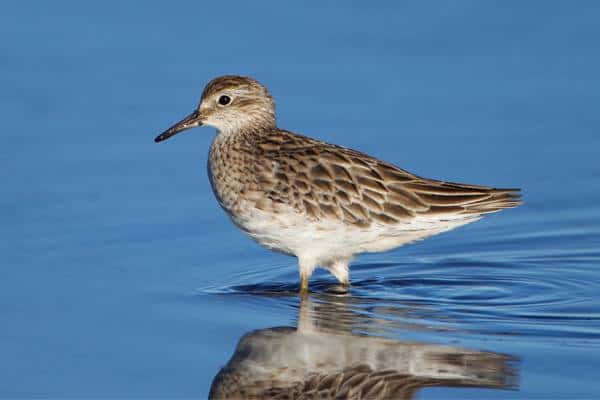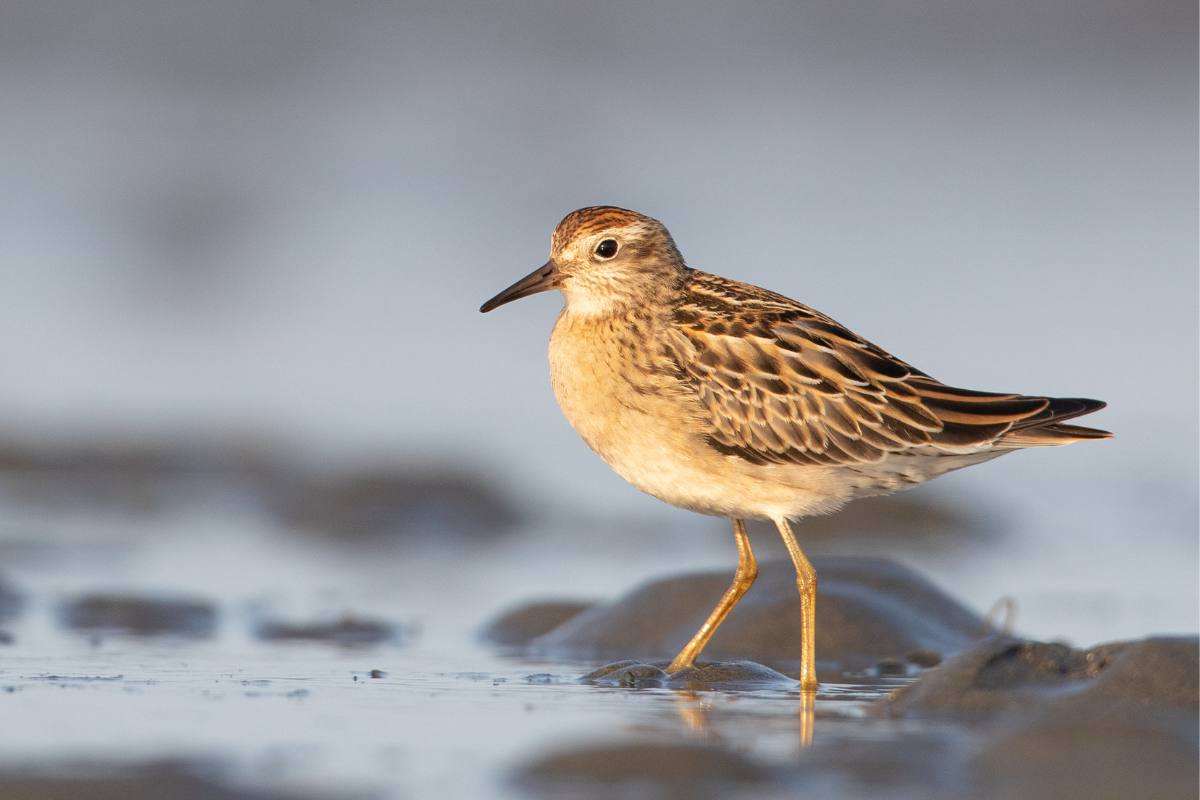Common Name: Sharp-tailed Sandpiper
Scientific Name: (Calidris acuminata)| Size | Diet | Range in Hawaii | Status in Hawaii |
|---|---|---|---|
| 7 in. - 8 in. | insects, worms, mollusks, and crustaceans | O'ahu, Maui, Kaua'i, Moloka'i, Lana'i, and Big Island | Vulnerable |
The Sharp-tailed Sandpiper (Calidris acuminata) is a small, migratory shorebird with a distinctive, sharply pointed tail and a long, thin bill that it uses to probe mud and sand for invertebrates. This delicate bird is known for its mottled brown plumage and striking yellow-green legs, and it breeds in the Arctic tundra and wetlands of northern Eurasia. While its range is primarily in Asia and Australia, the Sharp-tailed Sandpiper is a regular migrant and nonbreeding visitor to Hawaii.
Despite its infrequent sightings on the islands, the Sharp-tailed Sandpiper’s existence in Hawaii is a fascinating example of the bird’s ability to travel long distances and explore new territories.
Sharp-tailed Sandpiper
Appearance

This medium-sized shorebird boasts a slender build, measuring approximately 7 to 8 inches in length. Its distinctive features include a long, straight bill. Its wings, spanning around 14 to 16 inches, carry it effortlessly through the air as it embarks on its remarkable migratory journeys across vast distances.
The sharp-tailed sandpiper flaunts a striking plumage during the breeding season. Picture a mosaic of earthy tones, with a mix of browns, grays, and subtle hints of cinnamon adorning its feathers. These intricate patterns provide excellent camouflage against the coastal landscapes where they reside.
Diet
This feathered forager possesses a discerning palate, feasting on a variety of delectable treats found in its coastal habitats. As an adept probe-feeder, the sharp-tailed sandpiper utilizes its long, slender bill to explore the sand and mud in search of delectable morsels.
Its menu consists of a delectable assortment of aquatic invertebrates, including insects, worms, mollusks, and crustaceans. During their breeding season in the Arctic tundra, the sharp-tailed sandpiper expands its culinary repertoire to include nutrient-rich plant matter such as seeds, berries, and grasses.
Nesting
These remarkable shorebirds choose their nesting grounds with precision, seeking out the vast and pristine Arctic tundra. When the breeding season arrives, the sharp-tailed sandpiper engages in an elaborate courtship ritual, showcasing its vibrant plumage and engaging in captivating aerial displays. Once a suitable mate is chosen, the pair embarks on the construction of their nest, a meticulous endeavor.
The nest itself is a marvel of engineering, crafted with care using a blend of grasses, moss, and twigs. Its bowl-like structure is strategically placed in concealed depressions on the ground, camouflaging it from potential predators and the harsh Arctic elements. This clever adaptation ensures the safety and protection of the precious eggs and subsequent hatchlings.
Within this cozy haven, the female sharp-tailed sandpiper delicately lays her clutch of eggs, usually numbering around three to four. The eggs, typically adorned with a mottled pattern, resemble the surrounding landscape, providing further camouflage. Both parents take turns incubating the eggs, sharing the responsibility of keeping them warm and safeguarded.
After an incubation period of several weeks, a momentous event unfolds as the hatchlings break free from their delicate shells. These tiny chicks, covered in soft down feathers, embark on their first wobbly steps. Guided by their watchful parents, they begin to explore the world beyond the nest, gradually honing their skills and preparing for their incredible migratory journey ahead.
Behavior

One of the most awe-inspiring aspects of the sharp-tailed sandpiper’s behavior is its epic migratory journeys. Every year, these birds undertake an incredible feat, embarking on long-distance migrations that span thousands of miles. From their breeding grounds in the Arctic tundra to their wintering areas in the Southern Hemisphere, they traverse vast landscapes and overcome numerous challenges in search of favorable habitats and abundant food sources.
During their migratory flights, sharp-tailed sandpipers demonstrate remarkable group behavior. They often form large flocks, flying in synchronized patterns, creating an awe-inspiring spectacle as they navigate across diverse terrains. This collective behavior provides not only a sense of safety in numbers but also opportunities for efficient foraging and navigation.
When it comes to foraging, these birds showcase their skillful feeding techniques. Using their long, slender bills, they probe the soft substrate of mudflats and shorelines, skillfully extracting insects, crustaceans, and other invertebrates buried beneath the surface. Their precision and agility in capturing prey highlight their specialization in exploiting the rich resources offered by coastal habitats.
In addition to their migratory and foraging behaviors, sharp-tailed sandpipers exhibit fascinating social interactions. During the breeding season, males engage in competitive displays to attract females, showcasing their vibrant plumage and engaging in intricate aerial performances. These displays serve as both courtship rituals and territorial claims, adding an element of spectacle and competition to their behavior.
Furthermore, these birds are known for their gregarious nature, often forming mixed-species flocks with other shorebird species during migration and wintering periods. This cooperative behavior not only enhances their chances of survival but also fosters social interactions and mutual benefits within the avian community.
Habitat

During the breeding season, the sharp-tailed sandpiper seeks out the expansive Arctic tundra as its nesting grounds. Here, amidst the vast stretches of open, treeless landscapes, they create their nests in concealed depressions on the ground.
During migration, they can be found in a variety of coastal areas such as mudflats, marshes, and estuaries. During the winter months, the sharp-tailed sandpiper seeks refuge in the Southern Hemisphere, particularly in wetland habitats such as lagoons, salt pans, and coastal marshes.
Range
The Sharp-tailed Sandpiper is a migratory bird species that can be found in Hawaii, particularly on certain islands. In Hawaii, this sandpiper species is observed primarily on the islands of O’ahu, Maui, Kaua’i, Moloka’i, Lana’i, and Hawai’i Island.
On O’ahu and Maui, the Sharp-tailed Sandpiper has been recorded with high numbers, especially during fall migration. Locations such as Waipi’o Peninsula on O’ahu and Kealia Pond National Wildlife Refuge on Maui have seen significant concentrations of these birds, particularly during “irruption years” when their numbers are notably higher. Peak counts exceeding 100 individuals have been observed during these periods.
Kaua’i has also recorded sightings of the Sharp-tailed Sandpiper, although in lower numbers compared to O’ahu and Maui. Moloka’i, Lana’i, and Hawai’i Island have documented smaller populations of this sandpiper species.
The Sharp-tailed Sandpipers in Hawaii are irregular fall migrants, rare winter residents, and occasional spring transients. They exhibit a migratory pattern, successfully returning to specific wintering and staging grounds. Additionally, a few individuals have been known to over-summer on the islands.
Conservation Status
The sharp-tailed sandpiper (Calidris acuminata) is a migratory bird species with an interesting conservation status. Currently classified as “Vulnerable” on the IUCN Red List, this designation highlights the need for heightened conservation efforts to protect its populations.
Interesting Facts
1. “Dog-Leg” migration
First-year sharp-tailed sandpipers exhibit a unique migration pattern known as the “dog-leg” migration. Instead of following a straight route from Asia to their wintering grounds, they make a detour to staging grounds in western Alaska. From there, they continue their journey through the Aleutian Islands and across the western and central Pacific, including stops in Micronesia and the Hawaiian Islands, before reaching Australia and New Zealand.
2. Polygynous mating system
Male sharp-tailed sandpipers typically practice polygyny, meaning that a single male may mate with multiple females during the breeding season. They establish and defend territories, performing elaborate displays and vocalizations to attract females.
3. Cooperative feeding behavior
Sharp-tailed sandpipers sometimes exhibit cooperative feeding behavior during migration and on their wintering grounds. They form loose flocks and engage in “communal roosting,” where individuals forage together, benefitting from increased feeding efficiency and enhanced predator detection.
4. Nocturnal migratory behavior
During their migratory journeys, sharp-tailed sandpipers often undertake nocturnal flights. By traveling during the night, they can take advantage of cooler temperatures, less wind, and potentially reduce the risk of predation.
5. Exceptional wing loading
Sharp-tailed sandpipers have a unique wing morphology characterized by high wing loading. This means that their wings are relatively small compared to their body size, allowing for efficient flight over long distances and in strong winds.
Frequently Asked Questions
1. How long do sharp-tailed sandpipers live?
While the exact lifespan of sharp-tailed sandpipers is not well-documented, some individuals have been known to live for at least 7-8 years.
2. Do sharp-tailed sandpipers have any unique behaviors?
One unique behavior of sharp-tailed sandpipers is their “tail-wagging” display during courtship. Males perform this behavior by rapidly flicking their tail feathers up and down while singing to attract females.
3. Can sharp-tailed sandpipers swim?
While sharp-tailed sandpipers are primarily terrestrial birds, they are capable of swimming if necessary. However, they are more adept at wading through shallow water in search of food rather than swimming long distances.
4. Can sharp-tailed sandpipers hybridize with other bird species?
Hybridization between sharp-tailed sandpipers and other sandpiper species, such as pectoral sandpipers, has been documented. These hybrid individuals may display intermediate characteristics between the parent species and provide interesting insights into evolutionary processes.




